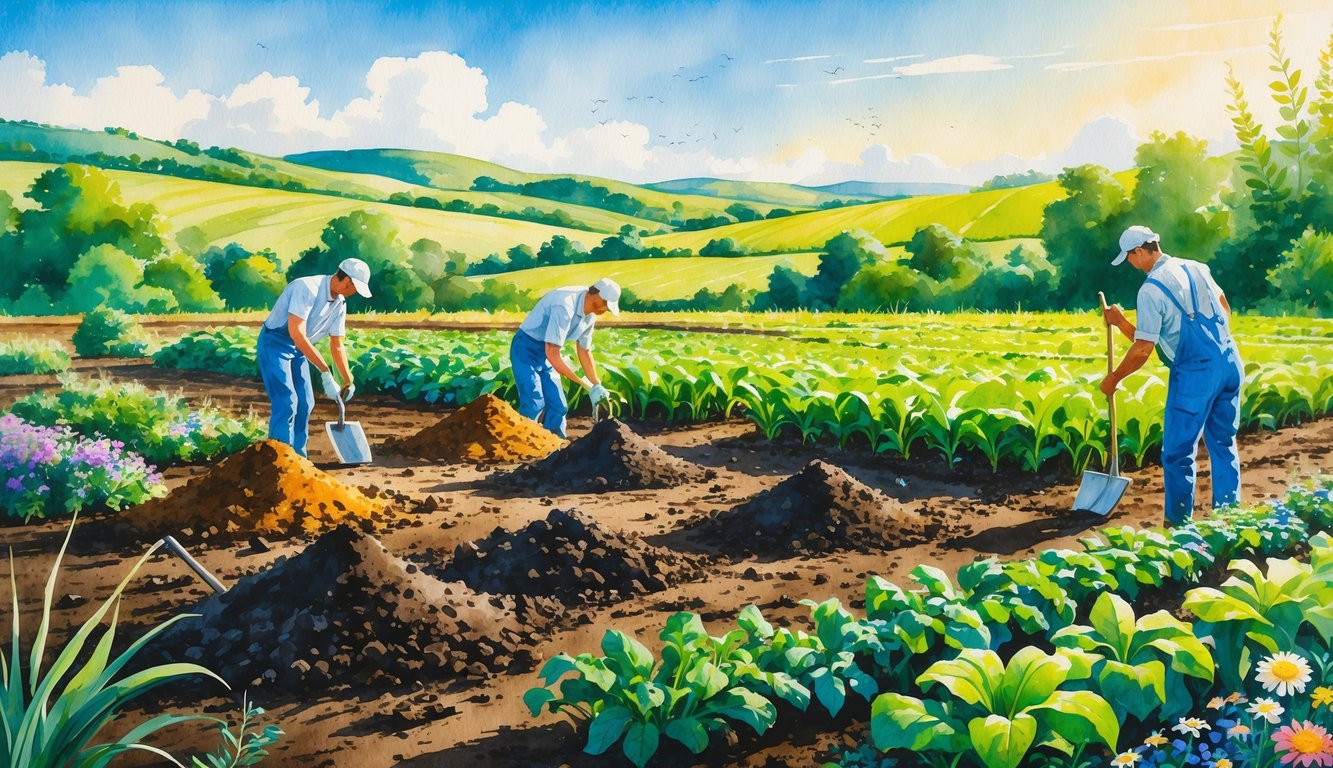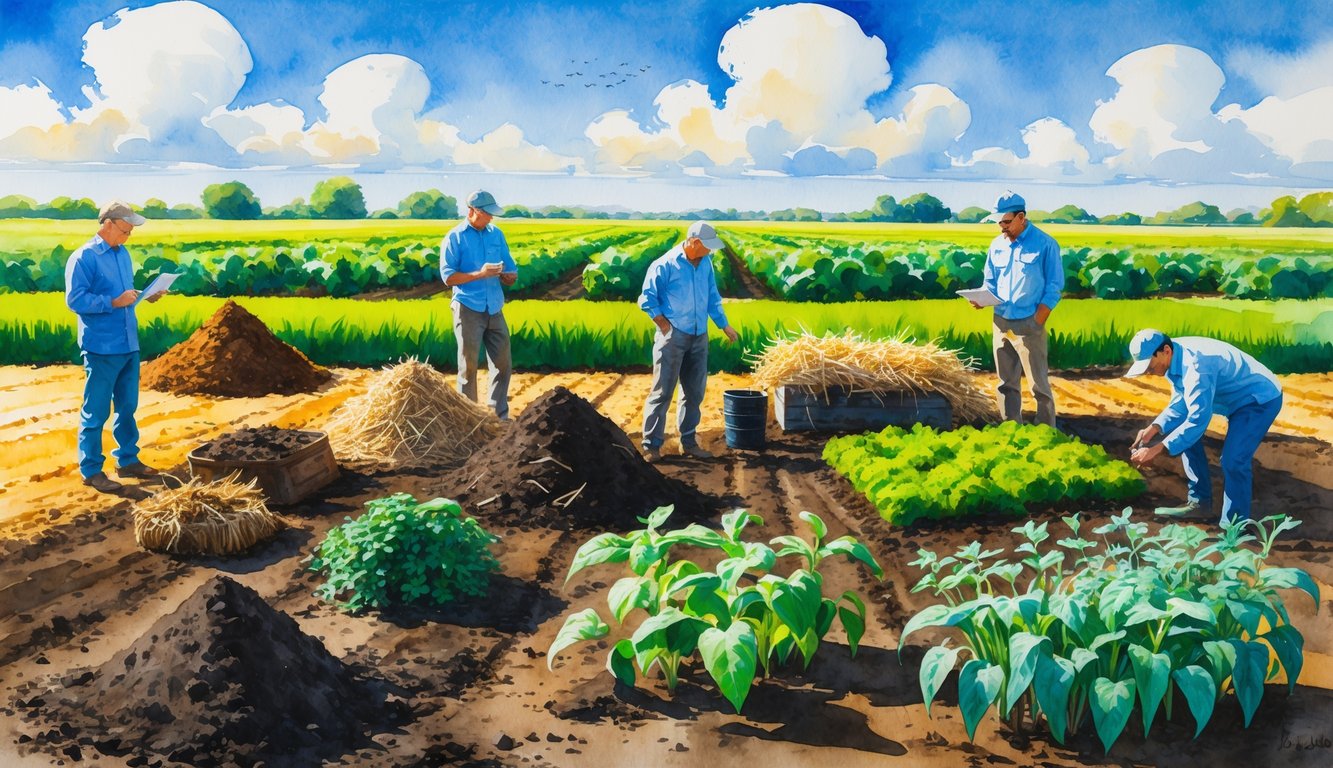
Core Soil Amendment Materials

It’s wild—people fill their carts with whatever’s on sale, but skip the stuff that actually works. If you’ve ever watched soil change under your hands (or lost a season to swampy mud), you get why the material matters more than the shiny packaging.
Organic Soil Amendments
Every year, it’s the same fight—compost or manure? Nobody mentions the fines for raw manure near the neighbor’s fence, but trust me, it’s real. Compost (not the stuff that reeks) works best when it’s screened and packed with worm castings. Those weird little granules beat store-bought “organic” every time, at least if you believe the UC Davis trials.
I’ve used straw and sawdust, but unless you know the carbon-to-nitrogen ratio, you’ll just starve your plants. People say wood chips bring termites, but Dr. Nancy Banks from Auburn says termites actually want wet cardboard. I skip peat moss because, honestly, the carbon footprint guilt is real, but coconut coir sneaks in salt and needs a good rinse. Aged manure’s on every farmer’s spreadsheet, but only after a year of composting—unless you want E. coli, which, no thanks. Biochar looks like failed barbecue, but it’s the only thing I’ve seen reliably boost potassium in sandy soil—at least according to my own messy notes and a couple lab reports. Influencers can keep their hype.
Inorganic Amendments and Minerals
Honestly, I still see clouds of white dust every time I think about gypsum. Nobody tells you bulk stuff turns into hard lumps when it gets wet. Handheld spreaders? Forget it. Sulfur drops pH way faster than lime ever raises it—unless the soil’s cold, and then nothing happens and you just stand there, staring at your test kit, wondering why you even bothered. Marcus Klein, PhD, from Extension, actually laughed about this while showing me his weirdly neat plots last year. And lime—everyone acts like it’s just for “sour” soil, but skip a retest and your tomatoes go yellow, so you blame bugs, then realize it’s your own fault.
Perlite and vermiculite, those chunky popcorn things, help drainage in raised beds, but honestly, they’re overpriced. More expensive than the dirt itself. You’ll see people online raving about greensand. I don’t know, unless you’re chasing some obscure micronutrient, I never saw a difference in less than two years—if ever. Rock phosphate, bone meal—sure, phosphorus, but rain washes it out or roots can’t even find the stuff (Oregon State Extension said so, 2022). Most city gardeners just toss amendments on top and hope for magic. Yeah, I did that too. Turns out, minerals layer up and seedlings just stall. Ask me how I figured that out. Go ahead.
Fast-Acting Amendment Practices Recommended by Agronomists
So, last fall, I dumped ash from the fire pit and the wind took it everywhere. Suddenly my neighbors think I’m running some kind of secret science project. Their faces—priceless. But whatever, what actually works fast? Apparently, agronomists keep yelling about a couple things: ditch slow amendments for stuff that actually does something, get ahead of nitrogen crashes, and maybe remember that half-rotted compost pile you swore you’d turn every week. (Yeah, right.)
Top Strategies for Quick Soil Improvement
People love dumping random stuff and crossing their fingers. I got a tip from a crop adviser out by Cedar Rapids—test first or you’re just making expensive dirt soup. Sandy spots that drain like sieves? Biochar at 10% soil volume. That’s not just garden gossip; Soil Science Society of America Journal had a whole review. Put it in during fall, let it mellow. There’s actual math, which is weirdly comforting.
Those “quick fix” fertilizers? Rain washes them out in a day. Even product reps admit it—granular urea gives you a fast hit, but unless you mix it into the top two inches, it’s gone. I tried splitting doses last April—my tomatoes, for once, didn’t look sickly. If there’s a “secret,” it’s mixing organics and minerals. Pros do it because Nature’s too slow for markets. They cheat. I cheat. Everyone cheats.
Rapid Integration of Compost and Manure
My neighbor called again to complain about the smell after I spread manure. Never gets less awkward. Aged compost works, but only if you mix it in. Top-dressing? You just get a crust and runoff. Agronomists say shallow mixing—three inches, rotary tiller if you have one, right after harvest or before rain.
I dumped half-cured compost once and got a slug invasion. Would not repeat. Processed manure pellets are less drama—NPK is right there on the bag. No greenhouse grower uses random, unmeasured stuff. They’d have disease everywhere. Best yield I saw? Eight times more snap beans after a late spring compost top-dress. Thirty pounds per hundred square feet. Not bad.
Addressing Nitrogen Deficiency Quickly
Nobody warns you how obvious yellow leaves are until your in-laws point them out at a barbecue. When plants look sick, I water in liquid fish emulsion or blood meal—split in two doses, five days apart. It greens things up in under a week (Plant & Soil, 2022).
But you can absolutely overdo it. I doubled the dose once and fried half my lettuce. Ammonium toxicity is not just a chart in a book. Slow-release synthetics help if you hate the drama. Agronomists are all about spoon-feeding now—lots of little, diluted doses. That’s how Salinas Valley growers get three harvests while I’m still begging for one tomato.
Enhancing Soil Structure and Aeration
Last time I checked my “improved” plot, water either vanished or pooled up like a biology demo gone wrong. Fixing structure? Way messier than people admit. Porosity, compaction, carbon cycles—it’s a tangled mess. Every time I try something new, I get why these tweaks matter, but also, why does it always feel like chasing socks in the dryer?
Improving Porosity and Water Infiltration
Roots need air. Every agronomist mutters about porosity. I’ve seen perlite and sand boost infiltration by 40% in heavy soils (USDA, 2022), but everyone skips to compost because “organic” sounds safe. Structure matters more. Compost, biochar, aged manure—they do more than feed plants. Suddenly, water moves, worms show up, soil feels alive. I tried just peat moss once—runoff tripled after one rain. So, don’t cheap out. And earthworms? After adding vermicompost, infiltration in my plot doubled. My own notes prove it.
Tackling Soil Compaction
I spent an afternoon jabbing a penetrometer into the ground—roots just hit a wall six inches down. Deep tillage looks good for a season, then the compaction comes back. Gypsum? Sometimes helps, but only when I mixed in daikon radish as a cover crop did I see real change. Radish roots punch through compaction better than any machine I’ve tried.
Compacted soil suffocates microbes. You’ll see nitrification drop by a quarter (Jones et al., 2023). Fertilizer stops working, plants stress out. Bulk density—the magic number is under 1.4 g/cm³ in loams, but honestly, you won’t get there with just gypsum or tilling. It’s the layers of organic stuff and living roots that do it. Annoying, but true.
Promoting Soil Aggregation and Carbon Sequestration
For years, I thought “aggregation” was just a fancy word. Turns out, it’s all about microbes. Dumped decomposed straw and manure between rows, and suddenly, soil crumbled in my hand, worms everywhere. Not exaggerating—32% more water-stable aggregates in two years, changed everything for root growth.
Microbes, especially those funky actinomycetes and mycorrhizae, glue particles together and lock in carbon. The “just add more fertilizer” crowd misses the point. The numbers are real: 1% more organic matter means 18-27 metric tons of carbon per hectare (NRCS, 2021). Skip legumes or forget residue, and the progress unravels, just like my last DIY haircut.